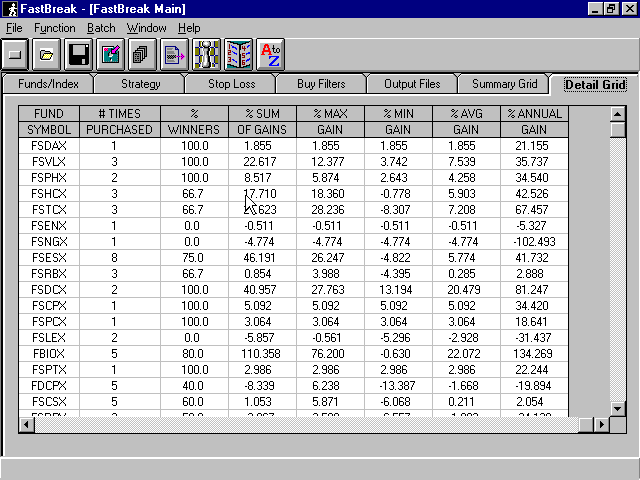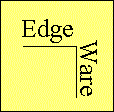 Edge Ware, LLC
Edge Ware, LLC Edge Ware, LLC
Edge Ware, LLC
![]()
FastBreak Standard
![]()
FastBreak was developed as an add on product for the FastTrack data base to test and trade using Fund Upgrading. Fund Upgrading is the most popular trading strategy used by FastTrack users with many traders showing impressive returns. Fund Upgrading rotates you out of under performing funds and into better performing funds. FastBreak will back test your trading strategy ideas to show you historical performance.
What Professional Money Managers and Individual Investors are saying:
"FastBreak has saved me years of work testing trading strategies. FastTrack's Maverick trading system was devised largely through use of FastBreak" Paul Charbonnet FastTrack Founder
"With FastBreak's easy Windows installation, you too can perform these ranking studies and seamlessly because of FastBreak's direct interface with FastTrack" FastTrack Monitor newsletter Spring 1996
"The FastBreak manual is a model of clarity" Nelson Freeburg Publisher of Formula Research
"Before I got the software I was going to take two months off from work to write ranking strategy software" H.L., MA
"I ordered FastBreak last week and I'm enormously pleased with the product! Excellent work!" J.H., PA
FastBreak Standard Version 6.8.2
Standard FastBreak has been available since 1996. We continue to add capabilities to adjust to an ever-changing market. Standard FastBreak was chosen as one of the best software tools in the Technical Analysis of Stocks & Commodities magazine 2004 Readers’ Choice Awards. We don’t advertise and the competition is fierce. A recent issue of the magazine listed nearly 300 different trading program tools available to investors.
Ordering information can be found at the end of this commentary or Click here for Order Info. There is upgrade pricing for current users of Standard FastBreak.
With the release of Version 5, we will no longer provide support to versions earlier than Version 4. We will continue to keep the final executable for all versions on our web site if users of the older versions need to reinstall on new computers.
We have written a separate commentary (commentary 8161) which describes some trading systems built with FastBreak Pro (commentary 8162). Trading systems built with FastBreak Pro can be run in Standard FastBreak. We have placed some of these trading systems on our web site for downloading.
Standard FastBreak and FastBreak Pro are identical with one very important exception, the Standard version does not contain the Genetic Algorithm optimizer and out-of-sample testing functionality. The optimizer in the Pro version allows nearly complete automation of the trading strategy building process. We recommend that anyone considering purchase of either Standard FastBreak or FastBreak Pro download the two manuals from our web site www.edge-ware.com There is a 30 day trial version of Standard FastBreak on the web site. This demo has full functionality but doesn’t show the most recent 60 days of trades. There isn’t a demo version of FastBreak Pro.
If you purchase Standard FastBreak and then decide to upgrade to FastBreak Pro within 60 days your purchase price will be credited toward the purchase price of FastBreak Pro.
See FastTrack Commentary 8162 for information on FastBreak Pro.
Capability to build market timing systems and signal files (see commentary 8161 for examples of how we have been using this capability)
We believe this is the most exciting new functionality. This functionality was developed, in large part, to better trade individual stocks. Over the years, we have found that FastBreak stock trading systems have the potential for fantastic returns, but we have also found that controlling drawdown is a challenge in bear markets. We have found that even in severe bear markets there will be stocks that rally strongly, however, these rallies often fail resulting in a whipsaw trades. We saw the need for market timing signals that would keep the trading system out of the very worst of markets. There are numerous market timing signals available but so many of these are not robust and fail the test of time. Also, we wanted to develop our own signals that met our needs, e.g., switches per year, drawdown, markets traded etc.
One disadvantage of the many market signals available is that they are developed for a specific index, e.g., S&P 500 Index. Often there is a divergence in different stock indexes, i.e., small cap stocks performing well while large cap stocks are not. FastBreak allows the use to combine multiple indexes (or any stock, fund, FNU file) into a family. This allows the user to build signals that stay in a buy mode if any of the indexes are in an uptrend and will only signal a sell signal if all are in a down trend.
We have used this capability to build signals for trading diversified mutual funds and individual stocks. We have also used it to build market sector specific signals; for example, we have built signals to build trading systems for energy stocks.
Signal file building systems can be run like a regular FastBreak trading system, except the output is a FastTrack signal file. This signal file can then be used in a FastBreak trading system or other FastTrack applications.
Ranking using Ulcer Performance Index (UPI). This option will purchase high UPI funds and produce strategies that have a high UPI equity curve. We have found this ranking method to be very effective in building more conservative trading systems.
Rank using Sharpe Ratio. This option will purchase high Sharpe Ratio funds and produce strategies that have a high Sharpe Ratio equity curve.
Changed the logic in the Harnsberger option. Previously, Harnsberger would only trigger a sell if you were not holding the top Buy ranked fund. This made sense on early versions of the program when we didn't have buy filters. Now, it is very common for you not to hold the #1 Buy ranked fund because of the filters. Also, with some users having large numbers of funds or stocks in their trading families, the difference in rate of change between the #1 Buy ranked fund and the Nth Buy ranked fund may be very small. However, the Nth ranked fund may meet all your buy criteria when the #1 fund does not. We changed the logic so that it will always try to buy a top ranked fund that meets your buying criteria.
Stop loss option using a short/long Exponential Moving Average (EMA) crossover. This option will stop you out of a trade if a short EMA crosses a long EMA. This is similar to the current EMA stop except that the fund NAV is smoothed with a short term EMA. We have found this to be a very effective stop option.
Buy filter using a short/long Exponential Moving Average (EMA) crossover. This filter will prevent purchase of a fund or stock that doesn’t have a short EMA above a long EMA. This is similar to the current EMA Buy filter except that the fund NAV is smoothed with a short term EMA. We have found this to be a very effective buy filter.
The next four enhancements are all similar in that they allow the user to modify stop or buy filter options according to market conditions. The modification is triggered when an index drops below its user defined EMA line. For example, if the S&P is used as the index, then the parameters are not modified as long as the index stays about a user defined EMA line. If the S&P falls below its EMA line, then a factor is applied to the standard value. A simple example is that when the market is in a strong uptrend, then high beta funds may be a good investment option; however, when the market is in a downturn or trading market, it may be prudent to purchase low beta funds. Of course, the genetic algorithm optimizer will find the parameters for you.
Adjust the Trailing Stop Loss value based on market conditions
Adjust the EMA Stop value based on market conditions
Adjust the Beta Buy filter value based on market conditions
Adjust the EMA Buy filter value based on market conditions
The Beta Buy Filter can now be a non-correlated beta as an option. If a fund has a low correlation to the index (typically the S&P 500 index) it can have a low beta but be a very volatile fund. An example would be a gold fund. Gold funds have a low or even negative market correlation and yet are very volatile. Filtering on standard beta may not filter out a gold fund. Using the non-correlated beta filter allows a user to mix a wide range of fund types including those that may not have a high market correlation value, e.g., bonds, international etc., in a trading family and have the ability to filter those with high volatility.
Improved the Better Opportunity Sell Signal (BOSS) stop option to be more effective with some ranking methods. This stop will sell a position and purchase a fund that is moving up at a very rapid rate.
Ability to begin the effectiveness of a stop option later than the first day. Previous versions required the stop to be in effect on the first day a fund was purchased. Some users have the requirement to hold a fund for a fixed number of days after purchase. They can now start a stop after this number of days.
Ability to search the Buy and Sell ranking list by fund symbol. Some users have very large trading families and it is difficult to locate a particular issue in the ranking list. This option allows the user to do an efficient search for the fund symbol.
FastBreak - The Market Sector Upgrading System
Market Sector Upgrading is the most popular trading strategy with FastTrackers. FastBreak is a FastTrack compatible product that tests market sector upgrading strategies then creates daily buy/sell signals once a strategy is put into practice. FastBreak is a Microsoft Windows product that is user friendly with a point and click interface.
Market Sector Upgrading
Concept: Buy the mutual fund (or stock) that is showing the best relative performance, and sell the fund that is lagging in performance. Funds and market sectors rotate in and out of favor include: the economic cycle, presidential cycle, interest rates, time of year or investor herd mentality. The "market" goes to extremes on different sectors and funds, for example, from loving health care, to hating health care, to loving technology, to loving utilities, to . . . FastBreak takes advantage of this love-hate-love cycle.
Why use FastBreak?
Although a simple concept, upgrading can be a rigorous exercise.
* What if I hold more that one fund at a time?
* What if I add or remove gold funds (or any other sector) from my family?
* What if I only hold the fund while it is in the top 20, 30, 40 % of my ranked family?
* What if I want to hold a purchase for at least 30 days to avoid trading fees?
* Can you trade between broad-based funds, or must I use sectors?
. . . These are the questions that FastBreak will answer.
Fidelity Selects, bond funds, and more
Many FastTrackers trade the Fidelity Select family with this strategy, but other families are usable. Conservative bond trading strategies can be developed by switching between long term, intermediate term, short term and money market funds as interest rates change.
In trading this strategy, some FastTrackers do a simple FastTrack ranking of their trading family over a fixed period - such as the last 20 trading days. The fund that is at the top of the ranked list is purchased and held until it drops to a lower point in the rankings, say half way. The money from the fund sold is used to purchase the new fund at the top of the ranked list.
In the past, traders had to write complicated spreadsheets to answer these questions. FastBreak allows the user to backtest a strategy over any period in the FastTrack data base. You can develop general purpose strategies, as well as strategies for bull or bear markets.
Many Variables
Here are just some of the user selected variables in FastBreak:
* trading family
* fund to use as money market
* number of funds held
* minimum days to hold
* sales fee
* test start and end days
* trailing stop loss
* a buy ranking period that is different from the sell ranking period
You can even import funds or stocks not in the FastTrack data base using the FastTrack FNU file format.
FastBreak can read standard FastTrack signal files if market timing is made part of a strategy. Best of all, the program will try all combinations of buy and sell ranking periods looking for the best ranking periods.
Reports
FastBreak output for each strategy includes but not limited to:
* historical annual gain
* number of switches per year
* maximum draw down
* % winning trades
* Ulcer Index and Ulcer Performance Index
* Beta and Alpha
The output can be sorted by each of these output values or imported into a spreadsheet. A detailed listing includes but is not limited to:
* name of each fund traded
* trade dates
* gain on the trade
Statistics for all traded funds are created to show which funds in the family have the best performance and which funds to remove for improved trading performance. FastBreak creates a standard FastTrack FNU file so you can see your results using all your favorite FastTrack tools.
The following steps explain the basic procedure for testing and building systems. There are many other options for the user to build more complex systems.
Step (1)
Select a trading family and money market. This can be an existing FastTrack family or a custom family of funds or stocks. For example, we have built and are trading systems using the following families:
Fidelity Sector funds
Rydex funds
International funds
Conservative/Bond fund family
Aggressive growth
Stocks in the S&P 500 index and the NDX index
Family of energy stocks

Step (2)
Choose from a wide range of ranking methods (including - UPI, Sharpe Ratio, simple ranking, NCAlpha) and ranking time period. This is a measure of funds/stock momentum.
Choose the test period dates, number of funds to hold in the strategy, market timing signal file, trading fee parameters.

Step (3)
Choose from a wide range or stops (including – trailing stop, parabolic, EMA, RSI, Rate of Return). When a stop is violated a fund/stock will be sold. Note, FastBreak allows users to use two stop period ranges. For example, a user trading Fidelity Select funds may want a loose stop during the first 30 days a fund is held. This may prevent getting stopped out an incurring a short term trading fee. After 30 days the stop can be tightened.

Step (4)
Choose from a wide range of buy filters (including – beta filter, parabolic, EMA, RSI, Rate of Return). These are filters that a fund/stock must pass before it can be purchased. A common example is to specify that a fund be above a 50 day moving average before it can be purchased.
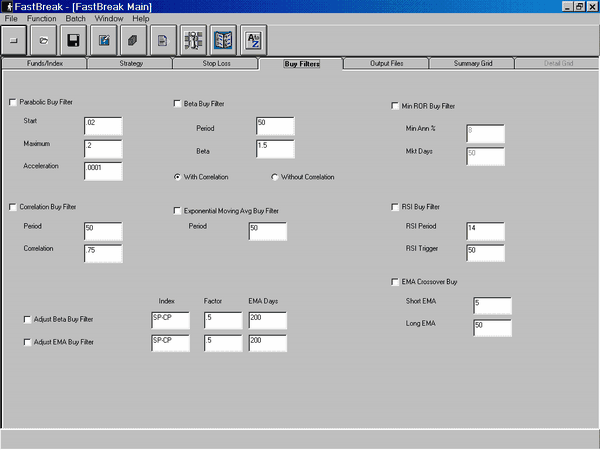
Step (5)
Choose the type of output files you want (Summary, Detail of all trades, FNU equity curve that can be graphed in FastTrack, Signal File)

Step (6)
Click the execute button and FastBreak will generate reports on the historical performance of this trading system.
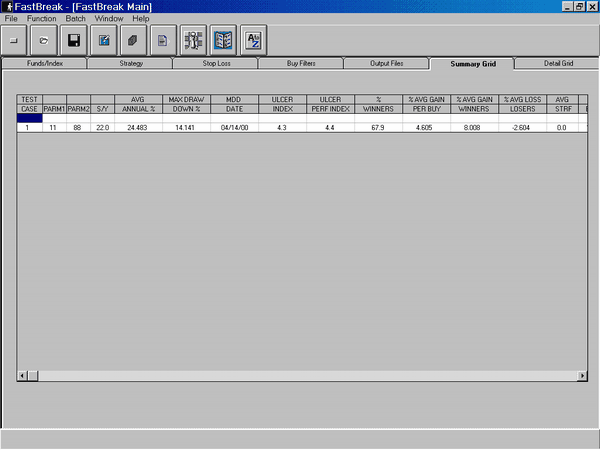
Click on the Detail Tab and you can see all historical, current trade positions and a notice if a trade it to be made the next day.
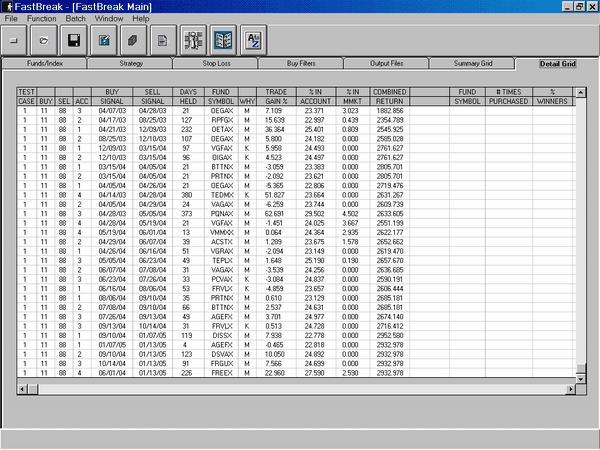
Our manuals provide additional guidance on how to use spreadsheets and our companion product, FastGraph, to more easily build robust trading system. Please download the FastBreak manual for details.
If you have any questions about ordering contact us at email2ew(remove this)@edge-ware.com
All orders receive an installation CD and hard copy manuals.Standard FastBreak IS NOT offered with a money back guarantee. If you are not sure Standard FastBreak is for you, we recommend going to our web site ( www.edge-ware.com ) and download the complete FastBreak manual and 30 day demo program. You can also download the sample trading system from our web site and run them in the demo.
If you have additional questions we can be contacted at email2ew(remove this)@edge-ware.com We also have a discussion area on our web site where you can post questions. DO NOT CALL INVESTORS FASTTRACK for information!!
As the saying goes, "Past performance is not a guarantee of future results."
FastBreak Standard Version 4
FastBreak version 4 works with Windows to provide an easy to use graphical interface. FastBreak is easy to use for the beginner and has advanced features for the experienced user.
FastBreak provides many parameters including eleven strategy types:
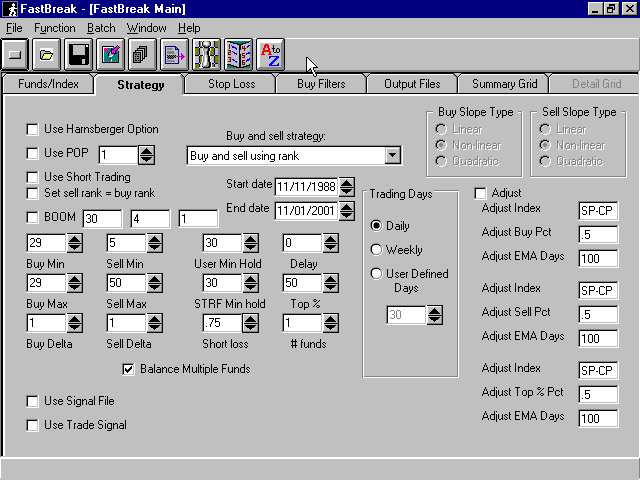
FastBreak provides many stop loss parameters including:

FastBreak provides many buy filter parameters including:
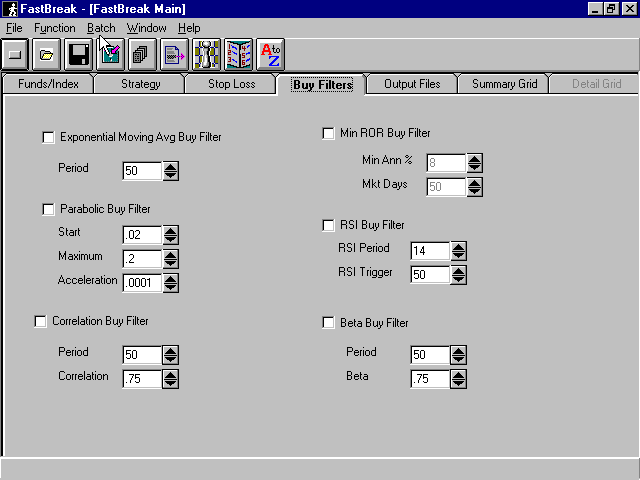
Some of the information FastBreak will provide on each trading strategy

FastBreak provides a detailed trading history of your trading strategy
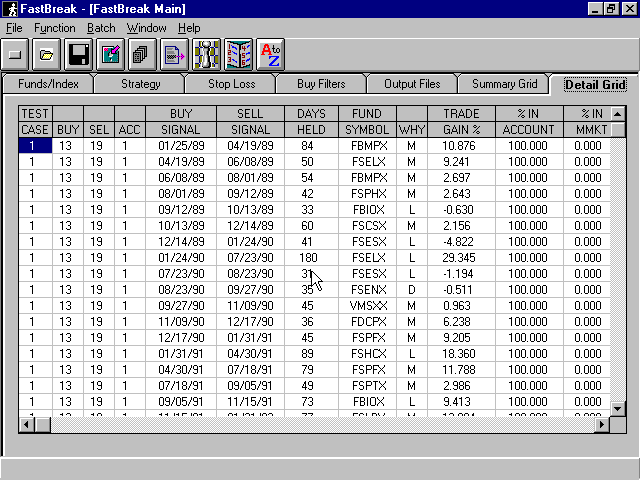
Specific details on each fund traded include
